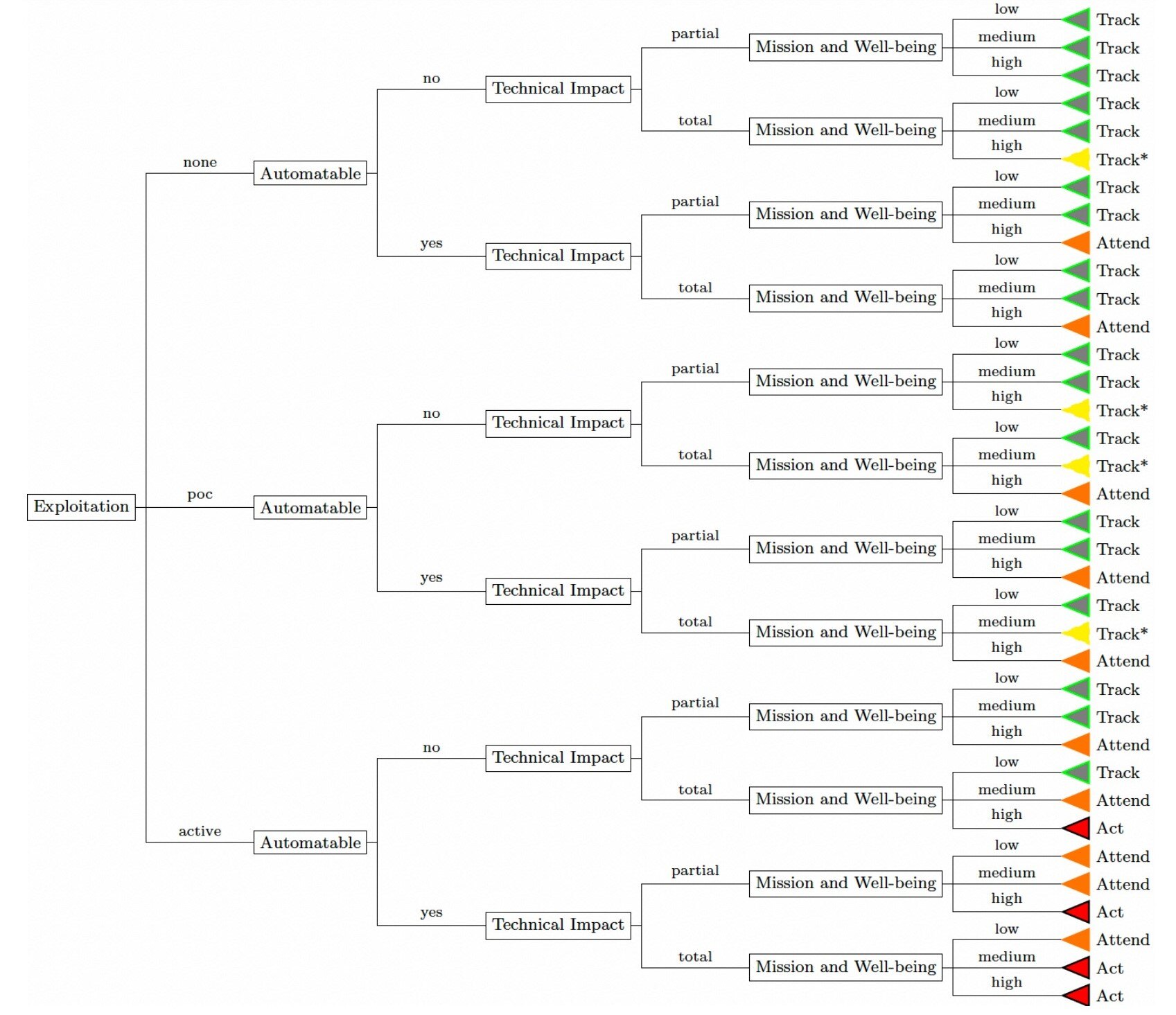Automate vulnerability prioritization and remediation in alignment with CISA’s Stakeholder-Specific Vulnerability Categorization model
Remediating vulnerabilities quickly is essential to prevent exploitation and breaches. CISA recommends the Stakeholder-Specific Vulnerability Categorization (SSVC) model to provide a structured framework for prioritizing vulnerabilities based on their impact and exploitation potential. The objective of SSVC is to “assist in prioritizing the remediation of a vulnerability based on the impact exploitation would have to the particular organizations,” thus ensuring efficient resource allocation and consistent decision-making across different stakeholders. SSVC uses decision trees to systematically assess the severity and impact of vulnerabilities, ensuring that resources are allocated effectively to address the most critical issues first, enhancing overall cybersecurity posture and reducing the risk of exploitation.
Prioritizing Vulnerabilities with SSVC
Looking at the SSVC decision tree, the process involves evaluating vulnerabilities through a series of decision points—each with defined values—to determine the appropriate action and urgency for remediation. The relevant decision points in the SSVC framework assess the state of exploitation, technical impact, ability to automate exploitation, mission prevalence, and public well-being impact of a vulnerability. Each point evaluates factors such as current exploitation status, level of control an attacker gains, ease of automation, criticality to mission functions, and broader impacts on safety and well-being. Based on these decision points, the tree helps determine the vulnerability prioritization and recommended action, including track, attend, or act.

SSVC Challenges
In practice, by accounting for diverse stakeholder roles and providing clear prioritization SSVC helps organizations improve their overall cybersecurity posture. However, manually working through the SSVC decision tree is challenging due to the time-consuming and resource-intensive nature of identifying, analyzing, and prioritizing vulnerabilities—which can lead to inconsistencies and delays in remediation. The manual process is prone to human error and lacks the efficiency needed to handle the constant influx of vulnerabilities effectively. Additionally, coordination between siloed security and IT operations teams can be a roadblock, resulting in slower remediation and increased risk of exploitation—this does not even include the manual process of patching the vulnerabilities.
Meeting CISA Recommendations through Automation
Identifying, prioritizing, and patching vulnerabilities can all be accelerated by many magnitudes with intelligent automation. For those following the SSVC model, OneSite Patch can help IT and security teams streamline the prioritization process through integrations with vulnerability management solutions and advanced automation capabilities.
Here’s how OneSite Patch aligns with the recommendations of the SSVC framework:
Prioritization and Clarity: The SSVC decision-tree framework enables stakeholders to prioritize vulnerabilities based on their specific context and the severity of the threat. OneSite Patch automates this process with built-in vulnerability data and integrations like CrowdStrike Falcon Exposure Management.

Risk-based prioritization within OneSite Patch categorizes vulnerabilities into four severity levels to help admins ensure that the most critical vulnerabilities are identified and prioritized effectively. Additional integrated intelligence, such as the CrowdStrike ExPRT.ai prioritization scheme, adds additional risk-based insight from real-world threat data. By integrating rating systems, OneSite Patch not only aligns with the SSVC goal of focusing on the most significant threats but prioritizes and acts on them automatically to cut through the noise—helping teams focus on the vulnerabilities that pose the highest risk, thus accelerating prioritization.
Efficiency and Resource Allocation: Ensuring resources are allocated to address the most critical issues first and improving efficiency is another outcome of SSVC model. However, OneSite Patch ensures that addressing vulnerabilities is not limited by time nor resources—and true efficiencies are gained by leveraging real-time threat intelligence and automating remediation processes.
Prioritization of vulnerabilities and patching is autonomous in OneSite Patch. Admins can automate the entire vulnerability patching process based on criticality or other priorities within their organization. Automated rollout processes within OneSite Patch include configurable alerts, approval workflows, and customizable schedules, ensuring that the most critical vulnerabilities are addressed first, and they are addressed according to organizational policies.
Proactive Defense and Continuous Improvement: CISA’s SSVC model intends to foster a proactive defense strategy by continuously improving vulnerability management processes, yet it is still limited by the abilities and workloads of IT and security teams who are often under resourced, stressed, and burned out.
OneSite Patch’s ability to automate the remediation process as soon as a patch is released allows organizations to preempt potential breaches without further burdening IT or security teams. This proactive approach aligns with SSVC’s goal of continuous improvement in vulnerability management.
Collaboration and Accountability: SSVC aims to enhance collaboration and accountability across different stakeholders involved in vulnerability management. OneSite Patch bridges the gap between IT operations and security teams and fosters a collaborative environment. Automated notifications and approval workflows ensure that all relevant stakeholders are informed and involved at the right time.
The ability to delegate approval responsibilities and automate the deployment process ensures consistent and timely responses to vulnerabilities, enhancing accountability.
Accelerating Prioritization and Patching:
While SSVC provides a valuable framework for streamlining vulnerability remediation, IT and security leaders can encounter many unknown variables within the decision tree. Manually evaluating, prioritizing, and patching vulnerabilities is just simply insufficient to keep pace with fast-moving adversaries. Security and IT leaders can turn to OneSite Patch, which automates and streamlines the entire patching process, allowing admin teams to avoid the painstaking process of deliberating over every decision point.
Real-Time Visibility and Control: Stakeholders require necessary visibility and control to manage vulnerabilities effectively as referenced in the SSVC model. OneSite Patch offers real-time visibility into patch compliance, status, and activity. Administrators can monitor deployments, identify gaps, and take corrective actions swiftly. Administrators retain full control over the patch management process, with capabilities to pause, cancel, or roll back patches as needed, ensuring minimal operational disruption.

Tailored and Flexible Patching Strategies: The decision points within the SSVC model allow for vulnerability management strategies that reflect varying risk-profiles. However, implementing customized processes and requirements manually—for every single vulnerability—adds a considerable amount of workload burden to both security and IT teams. OneSite Patch enables the creation of tailored patching strategies for different applications and systems. This flexibility ensures that each group of devices can be managed according to its specific requirements and business needs. Patches can be scheduled to minimize disruptions, with options for deploying updates during off-hours or maintenance windows, ensuring a balance between security and operational stability.
Conclusion
The SSVC model is crucial for providing a structured, stakeholder-specific approach to prioritizing and remediating vulnerabilities based on their potential impact and exploitation risk. IT and security teams should consider SSVC to ensure efficient, consistent, and proactive vulnerability management. OneSite Patch can streamline this process through automated prioritization and remediation. By bridging the gap between IT operations and security teams, OneSite Patch fosters collaboration, enhances accountability, and provides real-time visibility and control, all of which are crucial for maintaining a robust security posture in the face of evolving cyber threats.
To see how OneSite Patch can accelerate vulnerability patching for your organization, schedule a demo here.






